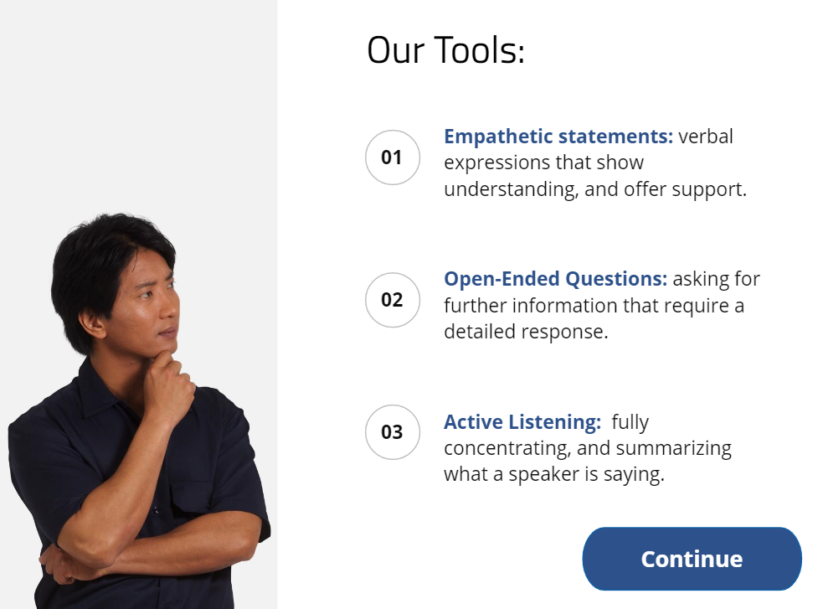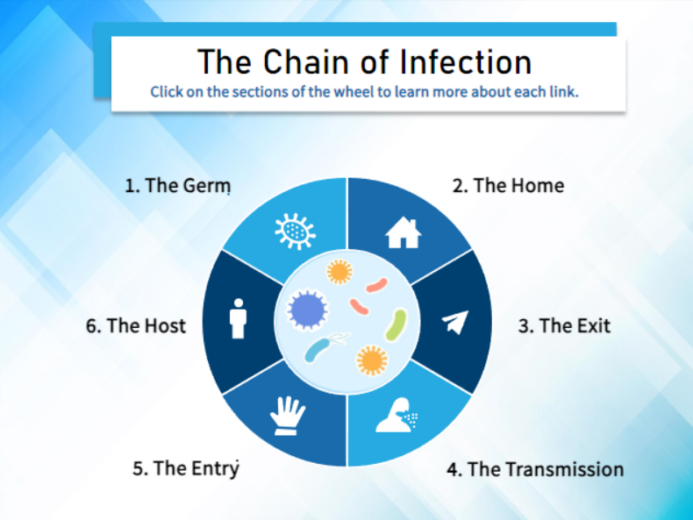Check out samples of the following below:
Action-Mapping
Micro-Learning
Training Evaluation
Video-Based Learning
Storyline 360
Rise 360
Action Mapping:
The Interview
A Customer Service Course levering Branching Scenarios

The Learning Problem:
Recent customer satisfaction surveys indicated a drift from a company’s standard customer service model specifically within loan intake appointments. A review of intake appointment notes found that about 40% of notes did not indicate a recommended service or an explanation as to why the customer was seeking a loan.
The Learning Solution:
This training was developed to address the following:
- The “Welcome Model” that provides a script for employees to follow when greeting customers
- A flow of engaging in an intake appointment with a focus on:
- Identifying the need
- Offering recommendations that can address the need
The full training takes the learner through a step-by-step branching scenario with a helpful guide along the way to show them critical pieces of information shared by the customer to use as an opportunity to seek further information and/or use this information to recommend products. At the end of the training, the learners need to intake a customer from greeting the customer, listening to the need, identifying key products to assist the customer and completing a summary note.
Theories Utilized
- Action-Mapping
Tools and Resources Utilized:
- Articulate Storyline 360
The Learning Problem:

I designed this training with a hypothetical issue in mind:
A company was conducting a two hour presentation on phishing emails every two weeks for new hire orientation. Outcomes were poor – about 80% of trainees were leaving the presentation only to click on a fake phishing email sent out to assess the presentation’s impact.
Resource hours were adding up as the company continued to grow by 33% every year.
The Learning Solution:
An interactive microlearning Storyline course was developed to accomplish the following:
- Provide learners practice identifying what to what out for in a phishing email
- Eliminate content that isn’t relevant to identifying phishing scams
- Reduce time in orientation so employees can report to their departments sooner.
Theories Utilized
- Action-Mapping
-
Mayer’s Cognitive Theory of Multimedia Learning
Tools and Resources Utilized:
- Articulate Storyline 360
- Vyond
- Adobe Audition
Project Overview:

I designed this training for the Association of Linen Management’s certification program for Linen Technicians. This course is broke up into four modules that prioritizes building knowledge of typical duties, common terms heard on the job, safety protocols, hospital regulations as well as building skills in identifying common misuses of hospital linen and communicating with various stakeholders around the hospital. At the end of the course, learners are expected to complete three branching scenarios that work through various requests linen technicians commonly encounter on the job.
I built this course off of an existing Linen Technician Handbook while working with stakeholders at ALM to ensure the course reflected key learning outcomes, content was viewed for accuracy by several subject matter experts, and the overall design was accessible for individuals interested in becoming Linen Technicians. This course was narrated by Sam Williamson from Suburban Tallyho Productions.
Tools and Resources Utilized:
- Articulate Storyline 360
- Vyond
- Adobe Premiere Pro
- Miro (for storyboarding branching scenarios)
Rise Course:
Providing Excellent Service to Members with Disabilities
Project Overview

This course was designed for member-facing staff at a credit union in response to a study conducted in 2022 that reported only 43% of Americans with disabilities utilize a bank or credit union to manage their finances primarily due to lack of accessible practices and poor customer service. Because this training was targeted toward member-facing staff, this course was designed in Rise 360 so that learners could easily pause their learning when required to assist a member and later reference the material as needed.
A design document was developed for this course to provide an overview of the training’s rationale, an overview of the learners, the learning objective refining process, and the course outline to meet those objectives.
Theories Utilized
- Constructivism: Allowing opportunities for a learner to reflect on the learning
- Behaviorism: Providing the learner opportunities to practice their learning
- Bloom’s Taxonomy: An Instructional Designer’s best friend! Used in developing behavioral and cognitive learning objective
Tools and Resources Utilized:
- Articulate Rise 360
- Articulate Storyline 360
Training Evaluation:
Effective Customer Service
Project Overview
This project’s goal was to assess the effectiveness from an in-person training on customer service skills for internal and external costumers via written communication. This training was determined to be required for all new staff, however, the anticipated number of new staff expected would grow at an exponential rate within the next year. This project’s goal was to determine staff groups that demonstrated the skills at a baseline level to conserve training resources.
Key outcomes
- Developed an objective behavioral assessment for ensuring staff were meeting requirements of addressing internal and external costumer within service model guidelines
- Outlined a long-term evaluation strategy to assess staff costumer service behavior and its impact on customer satisfaction.
- Identified areas for improvement within the training program to enhance staff behaviors in addressing customer needs via written communication.
Theories Utilized
- Kirkpatrick Levels of Evaluation
- Performance-Focused Learner Surveys
- Task Analysis
Tools and Resources Utilized:
- Adobe Premiere Pro
- Adobe Audition
- Powerpoint
Instructional Video:
Service Animal Etiquette
Project Overview:
This instructional video was made for a hypothetical community center who would be hosting a guide-dog training course over the summer. In order to set the community up for success, this video would be posted on the community center’s website in conjunction to PSAs posted around the center on service animal etiquette.
Theories Utilized
- Mayer’s Cognitive Theory of Multimedia Learning
Tools and Resources Utilized:
- Vyond
- Adobe Audition